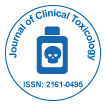
Journal of Clinical Toxicology
Open Access
ISSN: 2161-0495

ISSN: 2161-0495
Perspective - (2025)Volume 15, Issue 2
Cutaneous toxicology, the study of toxic effects on the skin due to chemical exposure, has emerged as a vital branch of toxicological science. As the body’s largest organ and first barrier against the external environment, the skin is constantly exposed to a wide range of harmful substances, from industrial chemicals and environmental pollutants to cosmetic ingredients and pharmaceutical compounds. Despite its barrier function, the skin can serve as a portal of entry for toxicants, especially those that are lipophilic or capable of penetrating the stratum corneum [1]. The study of cutaneous toxicology is therefore not only essential for understanding local dermal effects but also for assessing systemic toxicity resulting from dermal absorption.
Skin toxicity can manifest in various forms, including irritation, allergic reactions, chemical burns, phototoxic responses and chronic effects such as dermatitis or carcinogenesis. One of the most common concerns is irritant contact dermatitis, often caused by prolonged exposure to solvents, acids, alkalis or detergents that disrupt the skin barrier. In contrast, allergic contact dermatitis involves a delayed hypersensitivity reaction to allergens such as nickel, formaldehyde or fragrance components [2]. Repeated or prolonged exposure to these agents can lead to chronic inflammation, significantly impairing skin function and quality of life.
The cosmetic and personal care product industry presents a unique challenge for cutaneous toxicology. Consumers routinely apply products containing a complex mix of chemicals directly to their skin. While most ingredients are tested for safety, individual susceptibility, ingredient interactions and cumulative exposure can contribute to unexpected adverse reactions. Regulatory frameworks, such as those enforced by the U.S. Food and Drug Administration (FDA) and the European Chemicals Agency (ECHA), mandate rigorous safety testing, including patch testing and alternative in vitro methods to minimize animal testing.
Industrial and occupational settings pose even greater risks, where workers are frequently exposed to potent chemicals such as pesticides, solvents, dyes and metals. Occupational skin diseases rank among the most common work-related illnesses, with contact dermatitis accounting for a significant percentage of cases. Moreover, dermal exposure is often underestimated in risk assessments compared to inhalation or oral routes, despite its potential to cause both local and systemic toxicity [3].
Emerging contaminants such as nanomaterials and Endocrine- Disrupting Chemicals (EDCs) have also raised new concerns in cutaneous toxicology. Nanoparticles, due to their small size, may penetrate the skin and interact with cellular components in unpredictable ways. Similarly, EDCs present in plastics, cosmetics and personal care products may interfere with hormonal balance through dermal absorption, though more research is needed to quantify these effects [4].
From a public health perspective, climate change and increasing pollution levels are likely to amplify cutaneous exposures and reactions. Rising temperatures and UV radiation can enhance skin permeability and chemical reactivity, increasing the likelihood of phototoxic reactions. Additionally, populations in low- and middle-income countries may face heightened risks due to lax regulations and the widespread use of unregulated cosmetic and household products [5].
In conclusion, cutaneous toxicology is an increasingly important field that bridges dermatology, toxicology and public health. It plays a critical role in consumer safety, occupational health and regulatory science. Future advancements in predictive toxicology, including computational modeling and organ-on-a-chip technologies, hold promise for more accurate risk assessments and personalized dermatotoxicology. There is a pressing need for continued investment in research, public education and international collaboration to safeguard skin health in an increasingly chemical-laden world.
Citation: El-Karim O (2025). Cutaneous Toxicology and its Impact on Skin and Systemic Health. J Clin Toxicol. 15:590.
Received: 04-Mar-2025, Manuscript No. JCT-25-37525; Editor assigned: 06-Mar-2025, Pre QC No. JCT-25-37525 (PQ); Reviewed: 20-Mar-2025, QC No. JCT-25-37525; Revised: 26-Mar-2025, Manuscript No. JCT-25-37525 (R); Published: 01-Apr-2025 , DOI: 10.35248/2475-3181.25.15.590
Copyright: © 2025 El-Karim O. This is an open-access article distributed under the terms of the Creative Commons Attribution License, which permits unrestricted use, distribution, and reproduction in any medium, provided the original author and source are credited.